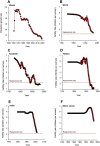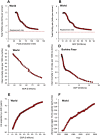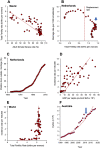The changing tide of human fertility
- PMID: 35079808
- PMCID: PMC8977063
- DOI: 10.1093/humrep/deac011
The changing tide of human fertility
Abstract
Over the past half-century, the world has witnessed a steep decline in fertility rates in virtually every country on Earth. This universal decline in fertility is being driven by increasing prosperity largely through the mediation of social factors, the most powerful of which are the education of women and an accompanying shift in life's purpose away from procreation. In addition, it is clear that environmental and lifestyle factors are also having a profound impact on our reproductive competence particularly in the male where increasing prosperity is associated with a significant rise in the incidence of testicular cancer and a secular decline in semen quality and testosterone levels. On a different timescale, we should also recognize that the increased prosperity associated with the demographic transition greatly reduces the selection pressure on high fertility genes by lowering the rates of infant and childhood mortality. The retention of poor fertility genes within the human population is also being exacerbated by the increased uptake of ART. It is arguable that all of these elements are colluding to drive our species into an infertility trap. If we are to avoid the latter, it will be important to recognize the factors contributing to this phenomenon and adopt the social, political, environmental and lifestyle changes needed to bring this situation under control.
Keywords: ART; fertility rates; genetics; population growth; social factors; sperm counts; testicular cancer.
© The Author(s) 2022. Published by Oxford University Press on behalf of European Society of Human Reproduction and Embryology.
Figures



References
-
- Aitken RJ. The Infertility Trap; Why Life Choices Impact Your Fertility and Why We Must Act Now. Cambridge, UK: Cambridge University Press, 2022.
-
- Aitken RJ. The male is significantly implicated as the cause of unexplained infertility. Semin Reprod Med 2020a;38:3–20. - PubMed
-
- Aitken RJ. Impact of oxidative stress on male and female germ cells: implications for fertility. Reproduction 2020b;159:R189–R201. - PubMed
-
- Aitken RJ, Baker MA.. Oxidative stress, spermatozoa and leukocytic infiltration: relationships forged by the opposing forces of microbial invasion and the search for perfection. J Reprod Immunol 2013;100:11–19. - PubMed
MeSH terms
LinkOut - more resources
Full Text Sources
Medical
Miscellaneous

